The distinguished Zhejiang University professor expediently dismissed my youthful enthusiasm over what I thought was a great new discovery. The year was 2006 and I had just stumbled into a city without people for the first time. I raced back to Hangzhou to file my report with Chinese academia – who were apparently already aware of my findings, and weren’t interested. “Those places are everywhere,” was the response.
It happened in the small city of Tiantai, which is around two hours south of Hangzhou. I made a wrong turn when walking out of the bus station – instead of going right and into the established, populated part of the city, I went left, and ended up in a completely new and utterly empty district. I remember gazing upon the freshly built, gray-tiled five-story buildings that surrounded me. Their windows and doors were dark, lifeless cavities, their interiors bare concrete shells, devoid of all signs of life. The street grid, buildings, and public squares were all created in a singular blast of construction. The design was cobbled together on computers, projected onto screens in boardrooms, and made into little plastic scale renders before being pasted upon the loamy river valley soil of Tiantai.
This was a few years before the first reports about China’s ghost cities began surfacing, and I had no reference for what I had observed. My enthusiasm was quickly judged naive upon my return to Hangzhou. But there was something about my professor’s words – “Those places are everywhere” – that stuck with me. I began looking for those scantily populated new towns. It was about as challenging as taking a bus to the outskirts of a city, getting off, and looking around: Almost invariably there would be a vacant new town or one that was under construction. These empty cities truly were everywhere, but why? How could a country with over a billion people and such a high demand for quality urban housing have so many homes with nobody living in them and entire cities without people?

































